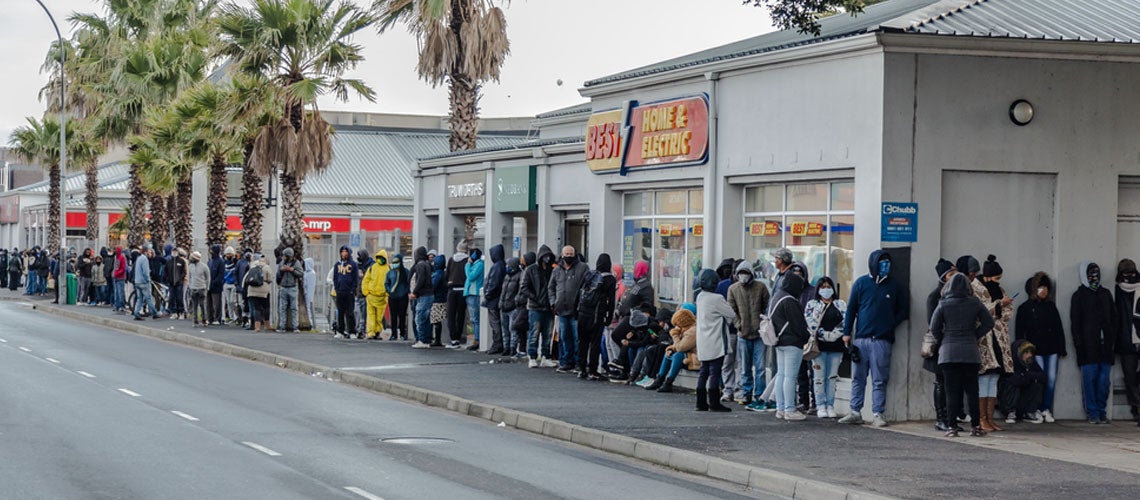 Lines of people waiting for financial assistance in Cape Town. Shutterstock.
Lines of people waiting for financial assistance in Cape Town. Shutterstock.
Originally published by Brookings and Business Day (South Africa) October 13 and 10, 2023
At over 30%, unemployment is South Africa’s biggest contemporary challenge. Of course, there are diverse reasons behind the incapacity of the South African economy to provide sufficient jobs for its working population but allow me to focus on one: limited financial incentives for a poor South African to look for employment. The key question in South Africa is not why people are unemployed, but rather why they should work.
The financial incentives to work are low
To answer this question, I simply calculate how much money a typical South African worker (Dumisani) entering the formal labour market is expected to bring home in comparison with a Vietnamese worker (Dung). In our example, let us focus on taxes and transport costs (Figure 1). This comparison demonstrates that a low-income worker in South Africa has realistically few incentives to work or at least much less than a worker in Vietnam, a country with rapid job growth.
For the same gross salary, a low-income South African worker will get less than half the money in his pocket than a Vietnamese worker
| DUMISANI | DUNG | |
| 25 years old. Lives in Soweto, Johannesburg. Works in Sandton, the business center of the capital city. | 23 years old. Lives in Tay Ho, Hanio. Works in the French quarter, the tourism center of the capital city. | |
| Gross salary | $1,000 per month | $1,000 per month |
| Personal income tax | $108 (tax allowance: $400; tax rate: 18%) |
$42 (tax allowance: $475; tax rate: 5% up to $215 and 10%) |
| Transport costs | $508 (57% of net wage) | $96 (10% of net wage) |
| In-pocket | $384 | $862 |
For the same gross salary of $1,000 per month (approximately R19 140), Dumisani keeps in his pocket less than half of the money that Dung would because of higher taxes and transport costs. Unfortunately, Dumisani is not an exception as the personal income tax is set at 18 % for those earning up to about $1000 per month in South Africa, while it is only 5% (up to $215 / R4115), 10 % (between $215 and $430 / R4115 and R8231), and 15% (between $430 and $760; R8231 and R14548) in Vietnam. The personal allowance, which can be deduced from the tax payment for a single worker, is also slightly lower in South Africa ($400 vs $475; R7657 vs R9093). Other East Asian countries, like Indonesia and Malaysia, also have personal income taxes with lower entry rates than South Africa.
South African workers like Dumisani are also heavily penalized by transport costs due to long commutes between townships and industrial/businesses centers, as a result of the legacy of Apartheid era spatial planning. Two economists from the Harvard Growth Lab (Shah and Sturzenegger) estimate that the average transport costs for those who are employed in South Africa is equal to 57% of net wages when time to commute is accounted for. According to their calculations, transport costs could exceed 80 percent for the lowest quintile of workers. In Vietnam, the same cost is estimated at only 10% of net wages because of shorter distances and more competitive modes of transport, including motorcycles.
In his decision to work, Dumisani will consider not only how much he will earn but also the amount of money that he could have expected from the government if he was not working. Like many low-income families, he or a member of his household would have qualified for a form of social transfers (grants/subsidies) distributed by the government. Today, it is estimated that over half of households are receiving money in one form or another from the State in South Africa. When becoming active in the labour market, Dumisani could lose some of these social benefits, including the unemployment insurance, the unallocated grants for low-income households (e.g., the COVID-grant), and the provision of free public services (electricity, water) to “indigent” households. By contrast, Dung is unlikely to receive any transfers from the government as social support in Vietnam is limited to few specific groups (war heroes, people living with disabilities).
Changing the relative price of work
Boosting employment could be achieved by changing the relative returns to a worker between being active or inactive in the labour market. My argument is this can be implemented by three policy changes or strokes of the pen that mainly require political consensus, not additional money.
- The Minister of Finance could initiate the first policy change. He can lower the entry tax rate of the personal income tax from 18% to, say, 5% or increase the threshold at which a citizen starts to pay the personal income tax. This is the East Asian model described above. While the benefit of this action is evident for low-income workers (they will take home more money), the costs will be minimal to the government as South Africa’s top decile contributes almost 80% of the personal income tax’s revenue.
- The second policy change, which may be more bolder and require concerted political will, would be for the authorities to modify existing social transfers to encourage poor workers to enter the labour market, including through reduced transport costs. A suggestion would be to replace (at least partially and for those ready to engage in work) the Social Relief Distress grant (about US$18.5 / R350per month), which was introduced as a temporary protective measure during COVID-19, by a direct subsidy that will help low-income workers keep more money in their pockets. The authorities could distribute a voucher through a phone application or an electronic card that beneficiaries will use to cover part of their commute costs. The amount of the subsidy could be adjusted to make the reform revenue neutral for the government.
- The third policy change will be to facilitate additional job opportunities closer to the homes of low-income workers – automatically reducing transport costs. This could be achieved by making it easier for existing small businesses to grow and operate, and for new ones to get started. Ecuador, for example, recently introduced a new type of company modality, (“Simplified Corporation Form”) available on a digital platform, leading to the creation of 43,000 companies in less than three years. Of course, the development of (small and micro) enterprises and self-employment – the main source of jobs in underserved areas--requires additional measures such as improvement in infrastructure, better access to finance, and skills, but this could be a starting point. This simple administrative change could be accompanied by targeted financial support and training programs as implemented in many low- and middle-income countries with extensive positive impact evaluation evidence.
Longer-term measures are needed to further enhance the mobility of poor workers
These short-term solutions can be attractive because they will encourage poor people to look for jobs and self-employment opportunities by making the relative price of labour more attractive in South Africa. They will also send an immediate signal about the government’s willingness to help disadvantaged workers to get more money in their pockets. However, in the longer run, the country’s ability to generate jobs will be largely determined by workers’ mobility, especially in urban areas where three-quarters of the labour force is concentrated today. The overhaul of the urban public transport systems, which are notoriously unreliable, unsafe and largely unregulated in the case of the taxi industry; and the development of new housing communities closer to industrial and business centers, will therefore have to be in the mind of every policymaker who wants to address the unemployment challenge in South Africa.


Join the Conversation